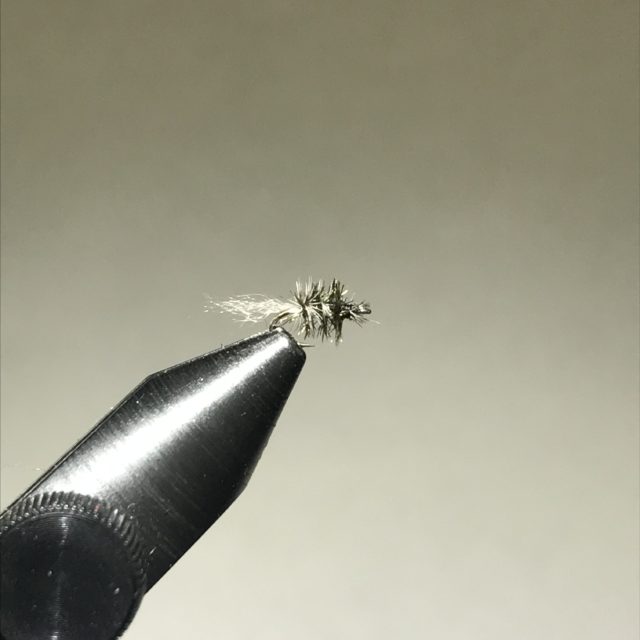Midge emergers did well for me during a fun over-nighter at the Deerfield and Farmington (here). In fact, two patterns absolutely crushed it.
At tailwaters, midges hatch year-round. They’re important bugs for trout, particularly when there isn’t a heavy hatch of something else happening.
At the Deerfield, a size 24 Roger Hill’s Stillborn Midge was very effective. Maybe it was luck, or maybe it was good timing, but this was the fly that the fish wanted during morning midge hatches.

The pattern is simple: a Griffith’s Gnat with a shuck of muskrat underfur. The trout were so picky that they wouldn’t eat a plain Griffith’s Gnat; the shuck was an important strike trigger. I read about the Stillborn Midge in Ed Engle’s amazing book, Tying Small Flies, which I recommend highly to anyone who fishes tailwaters.
It can be a pain to put tippet on a #24 fly, which is why I use the Orvis “Big Eye” dry-fly hooks. The eye is plenty big for my aging eyes and is critical during winter midge hatches, when my fingers are frozen.
In addition, I’ve been iterating on a midge soft hackle, and have come upon a pattern that has produced consistently the past few months. So, I feel comfortable enough to write about it. It’s worked so well that I’ve named it “The Mighty Midge.”

A size 22 of this pattern has worked well with multiple techniques: paired with a streamer, as part of a wet-fly rig, on a dry-dropper, and when fished solo (greased as a dry or sunken). So, it’s very versatile.
The “magic” materials are two-fold. First, I use starling feathers, which are fragile but small enough to work well on a small hook and have some cool iridescence. Other materials, such as spun black CDC feather fibers have worked, but the starling has outshone them all.
Second, I use the TMC 2488 hook. It has a 3x gape that I’ve found to be very effective at keeping fish hooked.
Now, there is a learning curve required to make such small flies. But, having a good magnifier-and-light set-up is critical (I use the Pro-Lite FTL 130). And, once you get the hang of it, you can bang out these flies extremely quickly.
In the spirit of continuing to fully disclose flies that have worked for me, the recipes are below.
ROGER HILL’S STILLBORN MIDGE
Hook: #24 Orvis “Big Eye” Dry-Fly Hook
Body: Peacock herl
Thread: Veevus 16/0, black
Hackle: Grizzly
Shuck: Muskrat underfur with guard hairs removed
THE MIGHTY MIDGE
Hook: #22 TMC 2488
Body: UTC 70 denier, black (rotate counter-clockwise to flatten the thread and create a smooth body)
Segmentation: Extra-small UTC wire, copper
Hackle: Starling
Enjoy!
Discover more from BlogFlyFish.com
Subscribe to get the latest posts sent to your email.

Thanks for sharing, interesting that the shuck would make such a difference.
The Mighty Midge and similar patterns have always worked for me especially at the Y-Pool. I tie the Partridge & Orange down to size 20 and a Pheasant Tail Soft Hackle (with starling feather hackle). When the trout are sipping emergers and won’t even look at my #26-28 midge dries, I’ll tie on these soft hackles with no weight, cast out to where the trout are, let the fly sink into the film, them strip it slowly and very often bang, a hit. For example, yesterday I used a #18 PhT soft hackle and a 18” small mouth bass grabbed it. A few runs and jumps later it was in the net. A caution with stripping soft hackles: any tippet smaller than 7X is recipe for break-offs; even 7X is risky as the fish grab it on the run and with that extra movement’s energy one has to set the hook very lightly, even to the point of NOT setting the hook to let the fish set itself. And, yes, I landed that bass on 7X!
Well-played, Gary!
When you swing the mighty midge is that usually part of a two fly rig or do you add some split shot to get it down? Also, as a dry|dropper do you add weight above this as a dropper or just let it sit in the surface film? Great little pattern, I’ve had good luck with it as a dropper on a tight line rig.
Usually part of a multi-fly rig and with a split shot.
I don’t dry-dropper much. If I did and with this fly, I don’t think I’d use any weight but it would depend on the depth and speed of the current.
I fish it as an unweighted dropper behind a dry fly with good results when presenting to rising fish that are looking for something in the film. If I want to fish deeper, I prefer a weighted fly. If you’re comfortable fishing shot with a dry dropper, it wouldn’t hurt to try it out if they didn’t eat it in the film.